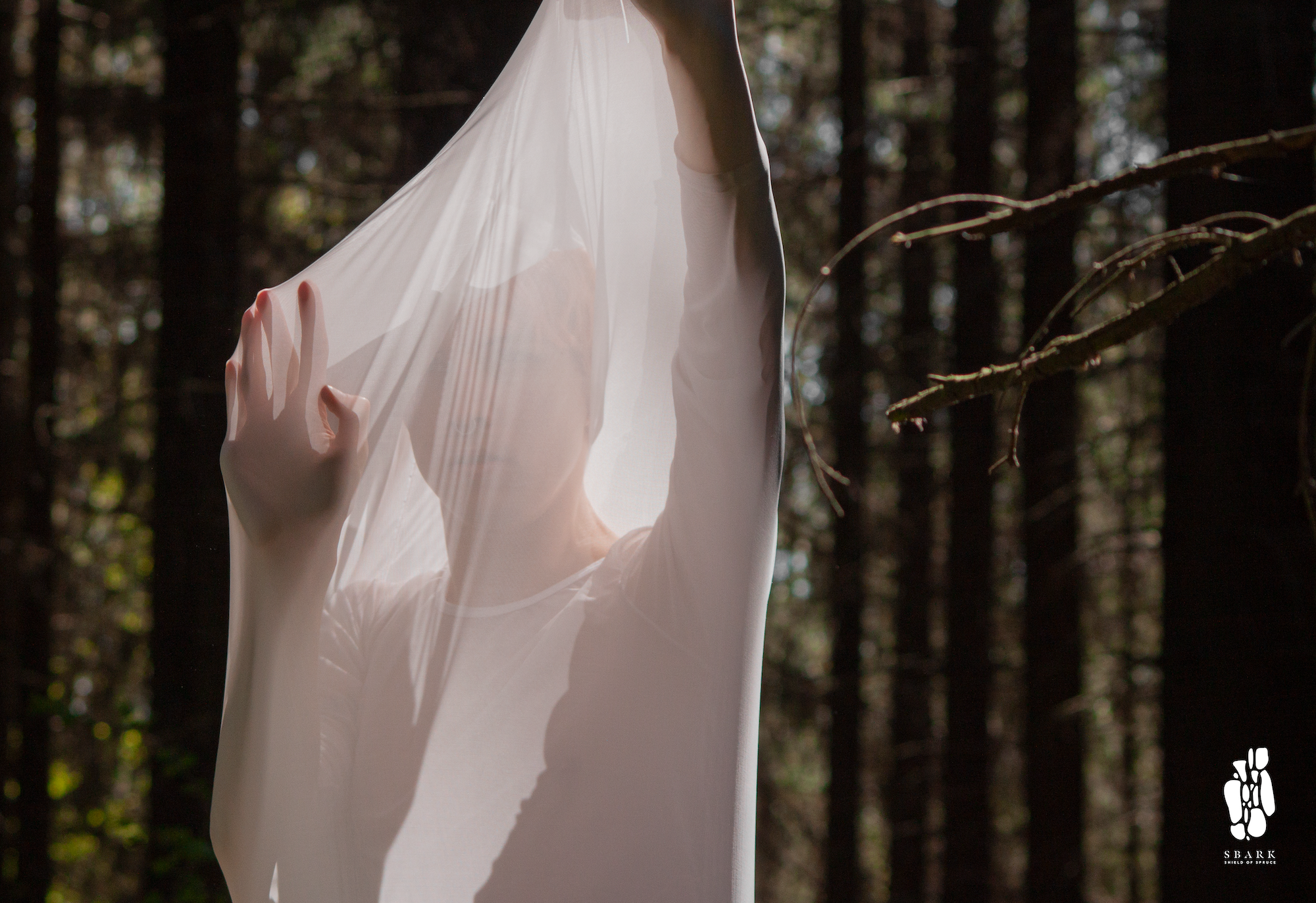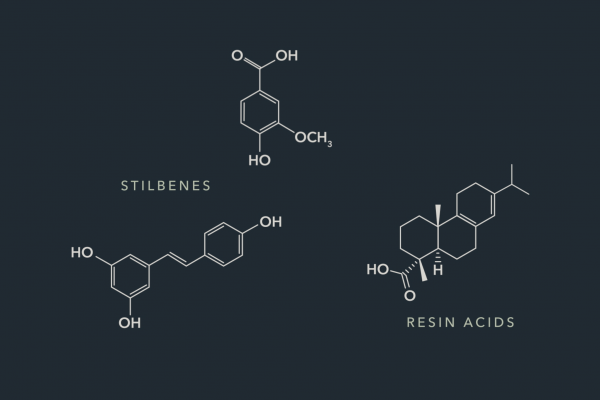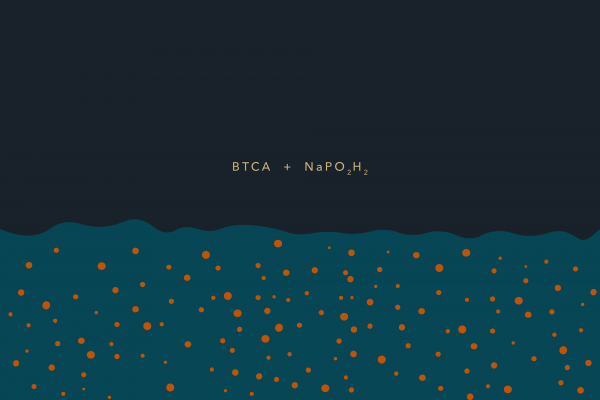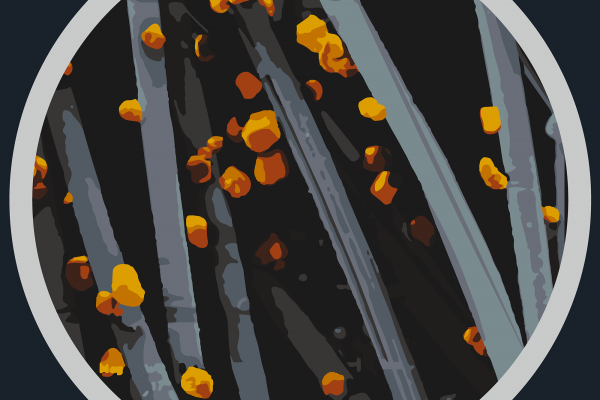
SBARK – Shield of Spruce is a project where spruce bark’s protective compounds are used to create an enhanced fabric. Spruce bark is exceptional in a range of trees because of its phenolic compounds, such as stilbenes, which provide protection against both UV-radiation and microbes.
By extracting protective compounds from bark and embedding them into man-made cellulose fibers, we answer the demands of the changing world in a sustainable way with lightweight, UV-protective and antibacterial fabric for different kinds of applications.
As the end result we present a speculative outcome, SBARK fabric, where the precious materials from spruce are transformed to function as a protection for humans.
Antimicrobial and UV-protective properties are generally added to fabrics to protect human users and prolong the life of textiles. Those properties are often achieved by applying heavy metal nanoparticles to fabrics, which are causing a threat towards water security as a heavy metal pollution.
Trend forecasts indicate consumers are going to demand more hygiene and personal protection from materials and products in a world after the coronavirus pandemic. Therefore, we wanted to find a local, natural and sustainable alternative for heavy metal nanoparticles.
Natural stilbenes are also strong blockers of UV radiation. Studies have shown these compounds to be comparable to commercial sunscreens in their UV absorptive capacity. This embedding of SBARK extract enables the creation of lightweight and breathable UV protective clothing for warm climates: shielding its user from harmful rays, as well as preserving vibrant colors and fiber integrity.
Around 70% of Finland’s land area is covered by forests. Norway spruce (Picea abies) is the second common tree in Finland and its stemwood is used in the forest industry to make timber, wood products and pulp. A single mill site in Finland may produce more than 50,000 tons of pure spruce bark in a year, which is now mostly used just to produce energy despite bark’s valuable compounds. Our team explored how to utilize this side stream in a more effective way.
SBARK – Shield of Spruce is a project by a team of six CHEMARTS alumni. The project is part of Biodesign Challenge (BDC) 2020 and it is the first time when a team from Aalto University is participating in the competition. Biodesign Challenge is an international education program and competition in the field of biodesign. The competition has been arranged every year since 2016. The BDC Summit 2020 will be held online on June 15th – 19th.
SBARK FABRIC
WORK IN PROGRESS
Team members
Megan McGlynn
I have recently graduated from Aalto University’s Master’s Degree Programme in Contemporary Design. My experimental design projects are often inspired by the sciences and are produced utilizing digital and traditional craft methods alike. I am currently researching digital drawing practices and self-forming shapes made from biomaterials.
Chiao-wen Hsu
I am currently studying in the Contemporary Design MA programme. With a background in Visual Communication Design and Crafts, I am passionate about the various attributes that different materials perform. In my recent projects, I employ materials as a vehicle to explore the complex relationship between human and nature and sustainable issues from different perspectives.
Iines Jakovlev
I am a designer interested in various fields of arts, crafts and design. I am a second year student in a Contemporary Design master program. At my Bachelor here in Aalto University I focused on industrial design, but got caught by materials. I love getting my hands on different textures, structures, shapes and feel. I am inspired by oddly satisfying things. My passions brought me to study at CHEMARTS, where I currently work as a mentor.
Eveliina Juuri
I’m just about to graduate from Aalto University’s Master’s Degree Programme in Contemporary Design. I like to call myself a multidisciplinary designer with a sustainability mindset. In my design work I always try to keep material choices in the core and how they can serve the designed purpose. In my Master’s thesis I had an opportunity to dive deeper into biodesign while I was working together with biochemists to find inherent colorants by utilizing microorganisms as a source for color.
Nina Riutta
I’m a versatile designer with a background in graphic design. The Collaborative and Industrial design studies in Aalto University have provided me with a wide skill set from design; from product and service design to academic research and bio-material development. At the moment I’m writing a Master of Arts thesis on knowledge sharing in biomaterial research. Beside the studies, I’m happy to support future material innovations by working within Chemarts as a mentor.
Aarni Tujula
I am a first year student in the Contemporary Design MA program. Before that, I studied in a Design BA program where I mostly focused on product design and ceramics. Later on, my interest in the field of design has grown more towards biodesign and sustainability issues. The topic of relationship between human and nature has inspired me a lot in my projects during the last two years of my studies. I see it sad but also interesting how we have disconnected from nature. I think we should learn from nature more. That way we could (re)connect with it and be more respectful towards it.
Instructors
Pirjo Kääriäinen, Professor of practice, Design-driven fibre innovation, Department of Design, Aalto University
Iina Solala, University Teacher, Department of Bioproducts and Biosystems & Postdoctoral Researcher, Materials Chemistry of Cellulose, Aalto University
Tapani Vuorinen, Professor, Wood Chemistry, Department of Bioproducts and Biosystems, Aalto University
Inspiration from forests
At least 70% of Finland’s land area is covered by forests, which is over 20 million hectares. It makes Finland one of the most forested countries in the world. The big percentage of the forested land area means also that people have easy access to the forest – visits in a forest on a daily basis is common for many people in Finland. The proximity of nature to everyday life has created a deep cultural bond.
There are many reasons why forests have always been very important to people in Finland. They have provided shelter for living, food, pharmacy, relaxation and livelihood. There are long traditions in the use of wood for papers, packaging materials, furniture, construction and interior materials.
Over time, there has been great respect towards nature in Finland. The anger of the forest was not wanted, which is why there were unwritten rules. For example, when picking berries, one was supposed to leave something back for the forest as a thank-you gift. Or if one wanted to build a house, he or she was supposed to sleep under a big spruce over a night to get an answer from nature if it was okay to build a house there.
Beliefs like those are not that common anymore, but what we can give is our respect in a form of protection. The use of forests must be done sustainably. We do not want to lose our precious forests and its diversity of life. Our team respects what forests can provide.
In our product, the forest provides inspiration, chemical compounds, and the composition of the fabric itself. Our mission is to gather and utilize these resources in a way that protects the user, as well as the environment it is sourced from – ensuring the health and longevity of these forests.
Extract
What makes spruce bark exceptional, is its concentration of phenolic compounds within the inner bark portion of the tree. By extracting inner bark, those natural compounds can be utilized.
The spruce inner bark extract contains natural stilbenes, which are important compounds in our project. Studies have shown that stilbenes are providing UV and antimicrobial properties. The spruce inner bark can contain up to 10 % of stilbenes and stilbene glycosides on its dry weight.
For the extraction, the inner bark must be separated from other parts of the tree. Our team did that by hand, but on a bigger scale, the sourcing of spruce inner bark could be integrated into the existing forest industry system. The bark would be collected from felled trees prior to storage, in order to preserve the active compounds.
In the industrial scale, extraction would be done so that ethanol is added to the bark and mixed with its existing water content. The mixture is then heated and pressed to remove the liquid, leaving the entirety of the bark solids to be used for energy production. The ethanol could be then recovered and recycled.
UV- and antimicrobial properties
UV-protective and antibacterial properties are often achieved by applying heavy metal nanoparticles to fabrics. Generally those fabrics do not breathe well and therefore are bad for summer months. Heavy metal nanoparticles are also causing a threat towards water security as heavy metal pollution. There is inadequate knowledge of any direct health risks in the use of clothing treated with biocides. Nanoparticles, for example which are commonly used as an agency, can cross the body’s natural barriers.
The extract from spruce inner bark contains stilbenes, such as resveratrol. These compounds are strong blockers of UV radiation in the range of 200-350 nm, absorbing a large amount of the wavelengths most harmful to humans. Danger zone for UVB is 280-315 nm and for UVA 315-400 nm. Studies have shown that by adding 2-5% of the spruce inner bark extract in the sunscreen, it is possible to get similar SPF (Sun protection factor) values as with commercial sunscreens.
The antibacterial properties result from a combination of several compounds, including stilbenes and various resin acids. While no single compound explains the effect, the extract shows strong antimicrobial activity against a broad spectrum of bacteria. Antimicrobial properties in fabrics help resist pathogens, provide a more hygienic garments, minimize body odor and allow for longer periods of use between wash cycles. With antimicrobial and UV-protective properties, SBARK is responding to a growing desire for personal protection in public environments.
Microencapsulating technology
Microencapsulating is a technology in which active substances are coated by tiny thin-walled capsules. The material of the capsule wall depends on the encapsulated compound and the fabric that the capsules are going to be applied to. In Fiedler J.O. et al. study (2019), Aloe vera microcapsules were studied and starch was used as the wall polymer. Microcapsules were applied to cotton non-woven. Man-made cellulose fiber is similar to cotton, therefore we hypothesise starch would work in our project to microencapsulate the extract.
These microcapsules can then be attached to the fabric through a bath containing butanetetracarboxylic (BTCA) as a binding agent and sodium hypophosphite (NaPO2H2) as a catalyst. In our concept, microencapsulated spruce inner bark extract would be attached during the finishing process of fabric. The capsules are located on the surface of fibers.
The technology helps to avoid rapid degradation of phenolic compounds and enables a slow-release of the extract over time.
References
Aalto University (2019, March 6). ‘It’s time for us to rediscover plants with natural textile fibres’ [News]. Aalto University. Retrieved from: https://www.aalto.fi/en/news/its-time-for-us-to-rediscover-plants-with-natural-textile-fibres (accessed 16 May 2020)
Burčová, Z., Kreps, F., Greifová, M., Jablonský, M., Ház, A., Schmidt, Š., & Šurina, I. (2018). Antibacterial and antifungal activity of phytosterols and methyl dehydroabietate of Norway spruce bark extracts. Journal of Biotechnology, 282, 18–24. doi: 10.1016/j.jbiotec.2018.06.340
EDANA (2020). Nonwoven industry’s response to the Eunomia study on the plastics definition under the Directive (EU) on the reduction of the impact of certain plastic products on the environment. EDANA. Retrieved from: https://www.edana.org/about-us/news/nonwoven-industry-s-response-to-the-eunomia-study-on-the-plastics-definition-under-the-directive-(eu)-on-the-reduction-of-the-impact-of-certain-plastic-products-on-the-environment (accessed 4 May 2020)
Fiedler, J. O., Carmona, Ó. G., Carmona, C. G., Lis, M. J., Plath, A. M. S., Samulewski, R. B., & Bezerra, F. M. (2019). Application of Aloe vera microcapsules in cotton nonwovens to obtain biofunctional textiles. The Journal of The Textile Institute, 111(1), 68–74. doi: 10.1080/00405000.2019.1625607
Harlin, A. (2019). Kestävä, kehittyvä kemia – seminaari Biomateriaalit uuden sukupolven tekstiileissä [PowerPoint slides]. https://www.ymparisto.fi/fi-FI/Kulutus_ja_tuotanto/Kestava_kehittyva_kemia_seminaari_312201(52428) Hermans, R., Kulvik, M. & Nikinmaa H. eds. (2007). Biotechnology as a competitive edge for the Finnish forest cluster. Retrieved from: https://www.etla.fi/wp-content/uploads/b227_Biotechnology-as-a-Competitive_Edge_-Finnish_-Forest_-Cluster.pdf
Koskisen’s wood procurement video. (2016). Video retrieved and copied with permission on 29th of May, 2020. Retrieved from: https://www.youtube.com/watch?v=AM9R_fOewMs
Ministry of Agriculture and Forestry of Finland (2019). Forestry and use of wood in Finland. https://mmm.fi/documents/1410837/12877048/Forestry+and+use+of+wood+in+Finland.pdf/2598dc7e-6992-9b97-1773-da94a1e903bd/Forestry+and+use+of+wood+in+Finland.pdf/Forestry+and+use+of+wood+in+Finland.pdf
Ministry of Agriculture and Forestry of Finland (2020). Forest resources in Finland. Ministry of Agriculture and Forestry of Finland. Retrieved from: https://mmm.fi/en/forests/forestry/forest-resources?fbclid=IwAR0saaTlzglrqmyFWxpiVkRRynQ1Y-G7s-Iy0LLT6H7EWVWXbn5fooRzjZc (accessed 5 March 2020)
Muthu, S. S. (2015). Handbook of Life Cycle Assessment (LCA) of Textiles and Clothing. Elsevier.
Natural Resources Institute Finland (Luke) (©2016). Tree species. Retrieved from: https://www.luke.fi/en/natural-resources/forest/tree-species/ (accessed 14 March 2020)
Routa, J., Brännström, H., Anttila, P., Mäkinen, M., Jänis, J. and Asikainen, A. (2017). Wood extractives of Finnish pine, spruce and birch – availability and optimal sources of compounds: A literature review. Natural resources and bioeconomy studies 73/2017. Natural Resources Institute Finland, Helsinki. Retrieved from: https://jukuri.luke.fi/handle/10024/540829
Sui, M. (20108). Spruce bark extract as a Sun protection agent in sunscreens. [Master’s thesis, Aalto University]. Aaltodoc. https://pdfs.semanticscholar.org/bb6f/1cabf13f0a74855bcaf8053e17bb25544b8b.pdf Swedish Chemicals Agency (2012). Antibacterial substances leaking out with the washing water–analyses of silver, triclosan and triclocarban in textiles before and after washing.
https://www.kemi.se/global/pm/2012/pm-1-12-antibact-en.pdf
Tanase, C., Cosarca, S., Toma, F., Mare, A., Cosarca, A., Man, A., Miklos, A. & Imre, S. (2018). Antibacterial Activities of Spruce Bark (Picea abies L.) Extract and Its Components Against Human Pathogens. Revista De Chimie, 69(6), 1462–1467. doi: 10.37358/rc.18.6.6347







